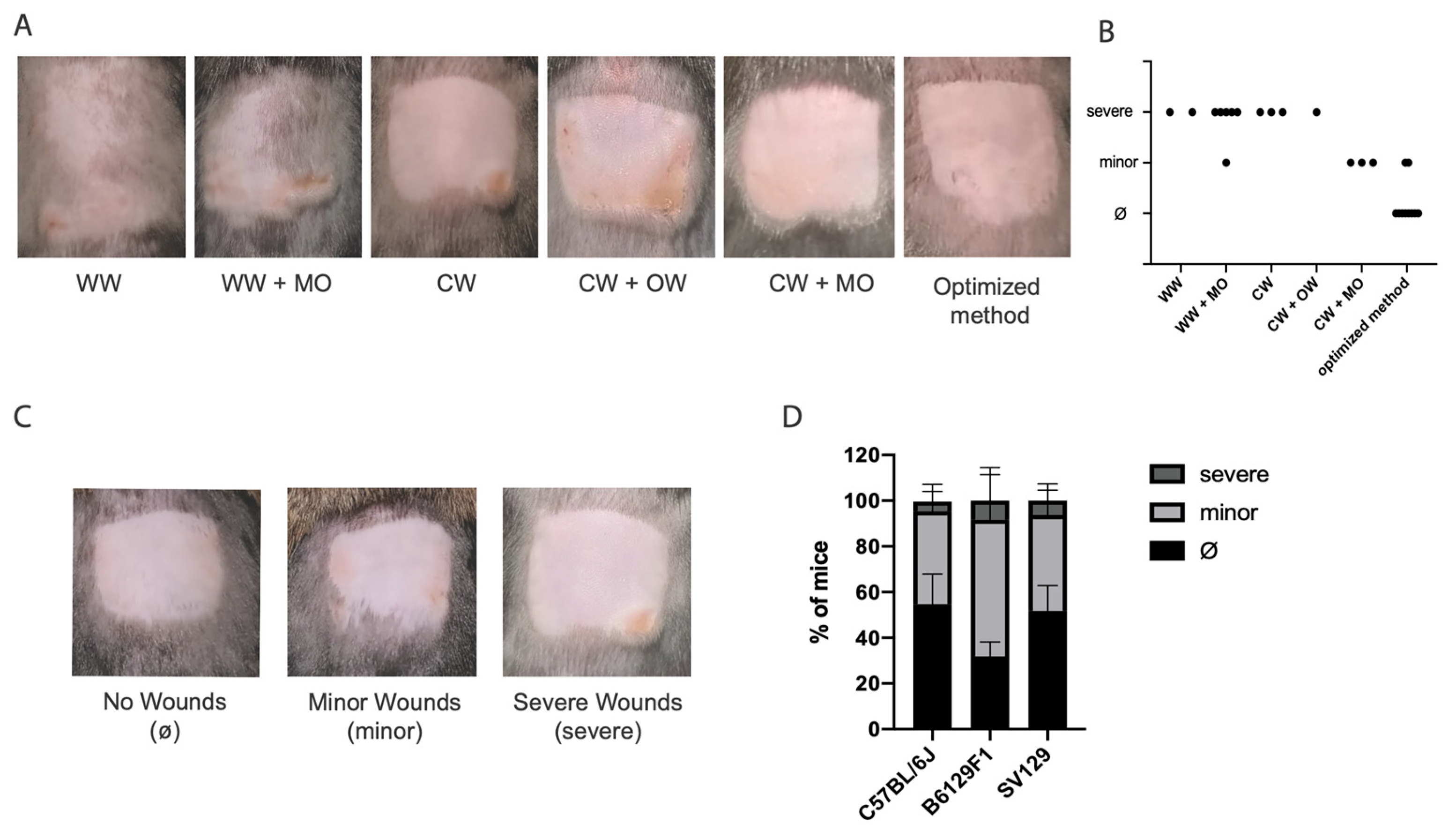Optimized Depilation Method and Comparative Analysis of Hair Growth Cycle in Mouse Strains
Abstract
Simple Summary
Abstract
1. Introduction
2. Methods
2.1. Mice
2.2. Optimized Depilation Method
2.3. Quantification of Wound Development
2.4. Hair Growth Analysis
2.5. Hair Cycle Analysis
2.6. Statistical Analysis
3. Results
3.1. An Optimized Depilation Protocol Minimizing Skin Injury

3.2. Hair Growth Cycle in Distinct Mouse Strains


4. Discussion
5. Conclusions
Author Contributions
Funding
Institutional Review Board Statement
Informed Consent Statement
Data Availability Statement
Conflicts of Interest
References
- Castro, A.R.; Portinha, C.; Logarinho, E. The Emergent Power of Human Cellular vs Mouse Models in Translational Hair Research. Stem Cells Transl. Med. 2022, 11, 1021–1028. [Google Scholar] [CrossRef] [PubMed]
- Muller-Rover, S.; Handjiski, B.; van der Veen, C.; Eichmuller, S.; Foitzik, K.; McKay, I.A.; Paus, R.; Stenn, K.S. A comprehensive guide for the accurate classification of murine hair follicles in distinct hair cycle stages. J. Investig. Dermatol. 2001, 117, 3–15. [Google Scholar] [CrossRef] [PubMed]
- Stenn, K.S.; Paus, R. Controls of hair follicle cycling. Physiol. Rev. 2001, 81, 449–494. [Google Scholar] [CrossRef] [PubMed]
- Plikus, M.V.; Chuong, C.M. Complex hair cycle domain patterns and regenerative hair waves in living rodents. J. Investig. Dermatol. 2008, 128, 1071–1080. [Google Scholar] [CrossRef]
- He, X.; Jia, L.; Zhang, X. The Effect of Different Preoperative Depilation Ways on the Healing of Wounded Skin in Mice. Animals 2022, 12, 581. [Google Scholar] [CrossRef] [PubMed]
- Paus, R.; Stenn, K.S.; Link, R.E. Telogen skin contains an inhibitor of hair growth. Br. J. Dermatol. 1990, 122, 777–784. [Google Scholar] [CrossRef] [PubMed]
- Fu, D.; Huang, J.; Li, K.; Chen, Y.; He, Y.; Sun, Y.; Guo, Y.; Du, L.; Qu, Q.; Miao, Y.; et al. Dihydrotestosterone-induced hair regrowth inhibition by activating androgen receptor in C57BL6 mice simulates androgenetic alopecia. Biomed. Pharmacother. 2021, 137, 111247. [Google Scholar] [CrossRef] [PubMed]
- Sequeira, I.; Legue, E.; Capgras, S.; Nicolas, J.F. Microdissection and visualization of individual hair follicles for lineage tracing studies. Methods Mol. Biol. 2014, 1195, 247–258. [Google Scholar] [PubMed]
- Sakai, Y.; Demay, M.B. Evaluation of keratinocyte proliferation and differentiation in vitamin D receptor knockout mice. Endocrinology 2000, 141, 2043–2049. [Google Scholar] [CrossRef]
- Joost, S.; Jacob, T.; Sun, X.; Annusver, K.; La Manno, G.; Sur, I.; Kasper, M. Single-Cell Transcriptomics of Traced Epidermal and Hair Follicle Stem Cells Reveals Rapid Adaptations during Wound Healing. Cell Rep. 2018, 25, 585–597.e7. [Google Scholar] [CrossRef] [PubMed]
- Lim, C.H.; Sun, Q.; Ratti, K.; Lee, S.H.; Zheng, Y.; Takeo, M.; Lee, W.; Rabbani, P.; Plikus, M.V.; Cain, J.E.; et al. Hedgehog stimulates hair follicle neogenesis by creating inductive dermis during murine skin wound healing. Nat. Commun. 2018, 9, 4903. [Google Scholar] [CrossRef] [PubMed]
- Hampton, A.L.; Hish, G.A.; Aslam, M.N.; Rothman, E.D.; Bergin, I.L.; Patterson, K.A.; Naik, M.; Paruchuri, T.; Varani, J.; Rush, H.G. Progression of ulcerative dermatitis lesions in C57BL/6Crl mice and the development of a scoring system for dermatitis lesions. J. Am. Assoc. Lab. Anim. Sci. 2012, 51, 586–593. [Google Scholar] [PubMed]
- Fischer, A.H.; Jacobson, K.A.; Rose, J.; Zeller, R. Hematoxylin and eosin staining of tissue and cell sections. CSH Protoc. 2008, 2008, pdb.prot4986. [Google Scholar] [CrossRef] [PubMed]
| Figure | Mice Strain | Age | Number of Animals | Notes |
|---|---|---|---|---|
| Figure 1A,B | C57BL/6J | 7 weeks-old | other methods n = 15 | |
| optimized method n = 10 | Animals also used for Figure 1D | |||
| Figure 1D | C57BL/6J | n = 19 | Animals also used for Figure 2 and Figure 3 | |
| B6129F1 | n = 17 | |||
| Sv129 | n = 17 | |||
| Figure 2 and Figure 3 | C57BL/6J | n = 19 | ||
| B6129F1 | n = 17 | |||
| Sv129 | n = 17 |
Disclaimer/Publisher’s Note: The statements, opinions and data contained in all publications are solely those of the individual author(s) and contributor(s) and not of MDPI and/or the editor(s). MDPI and/or the editor(s) disclaim responsibility for any injury to people or property resulting from any ideas, methods, instructions or products referred to in the content. |
© 2024 by the authors. Licensee MDPI, Basel, Switzerland. This article is an open access article distributed under the terms and conditions of the Creative Commons Attribution (CC BY) license (https://creativecommons.org/licenses/by/4.0/).
Share and Cite
Magalhaes, J.; Lamas, S.; Portinha, C.; Logarinho, E. Optimized Depilation Method and Comparative Analysis of Hair Growth Cycle in Mouse Strains. Animals 2024, 14, 2131. https://doi.org/10.3390/ani14142131
Magalhaes J, Lamas S, Portinha C, Logarinho E. Optimized Depilation Method and Comparative Analysis of Hair Growth Cycle in Mouse Strains. Animals. 2024; 14(14):2131. https://doi.org/10.3390/ani14142131
Chicago/Turabian StyleMagalhaes, Joana, Sofia Lamas, Carlos Portinha, and Elsa Logarinho. 2024. "Optimized Depilation Method and Comparative Analysis of Hair Growth Cycle in Mouse Strains" Animals 14, no. 14: 2131. https://doi.org/10.3390/ani14142131
APA StyleMagalhaes, J., Lamas, S., Portinha, C., & Logarinho, E. (2024). Optimized Depilation Method and Comparative Analysis of Hair Growth Cycle in Mouse Strains. Animals, 14(14), 2131. https://doi.org/10.3390/ani14142131






